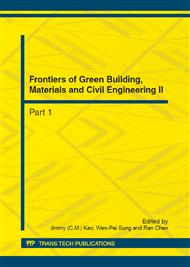p.1216
p.1221
p.1226
p.1230
p.1234
p.1239
p.1243
p.1247
p.1253
Calculation Method of Unlimited Passive Earth Pressure on Retaining Wall with Translation Mode
Abstract:
Passive earth pressure brought into play depends on displacement ratio, s/sc ,of retaining wall in site and limit state close. Base on friction angle discount coefficient and differential layer method,an estimating method for unlimited state passive earth pressure is set up for cohesiveless soil retaining wall with translation mode.Study indicates that values of passive earth pressure by method in this paper are lower than by Coulomb earth pressure theory.The difference of passive earth pressure by both methods is magnified with decrease of displacement ratio, s/sc and angle,β ,respectively. The critical angle of soil in here is smaller than Coulomb earth pressure theory and it diminishs with the decrease of displacement ratio, s/sc. Moreover, critical angle will minish with increase of angleβwhen displacement ratio, s/sc ,is immovable.Analytical results also show that action point of passive earth pressure is under 1/3 times height of retaining wall and keep descending with the increase of displacement ratio, s/sc ,and angle,β.
Info:
Periodical:
Pages:
1234-1238
Citation:
Online since:
August 2012
Authors:
Price:
Сopyright:
© 2012 Trans Tech Publications Ltd. All Rights Reserved
Share:
Citation:


